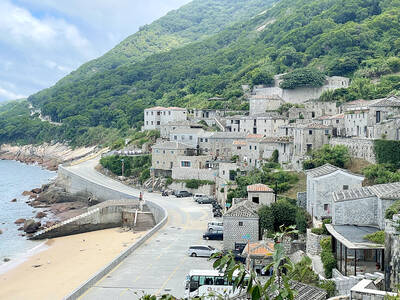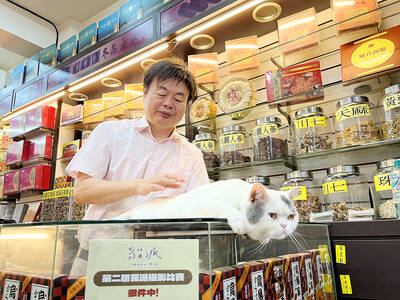Dozens of labor activists led by the Labor Rights Association demonstrated in front of the Chinese National Federation of Industries yesterday to protest the group’s opposition to raising the minimum wage.
The protest came in response to a joint statement issued by six major industrial and commercial organizations last week calling for less government interference in the minimum wage issue. They said wages should be decided by market mechanisms and should not be subject to intervention.
The Council of Labor Affairs is scheduled to meet on Monday with representatives from business and labor groups and academics to discuss whether to adjust the minimum wage.
Labor activists said the business groups are only interested in advancing their own interests, even at the cost of exploiting workers.
The protesters wrote “raise the minimum wage, protect workers’ rights” on a large banner and shouted “Businesses don’t care for worker benefits,” “Business groups are inhuman” and “Protect laborers’ rights.”
“The six major business groups completely disregard the widening gap between the rich and the poor in this country,” said Tang Shu (唐曙), secretary general of the Labor Rights Association.
The Directorate-General of Budgeting, Accounting and Statistics said on Aug. 19 that the annual average disposable income of the top 20 percent of income-earning households was 6.34 times that of the bottom 20 percent last year, the biggest rich-poor gap since 2001.
“Business leaders used to say that the minimum wage could not be increased because the economy was bad and because cross-strait trade relations are not open enough,” Labor Rights Association executive director Wang Chuan-ping (王娟萍) said. “Well, now, the Economic Cooperation Framework Agreement has been signed, and the economy is getting better — these businesses are making money, but they’re not willing to share anything with their workers.”
The protesters also slammed business groups’ efforts to decouple the wages of foreign workers from minimum wage regulations.
About 1.2 million workers, including 170,000 foreign laborers, now receive the minimum wage of NT$17,280 per month.
New Immigrants’ Labor Rights Association secretary-general Lee Li-hua (李麗華) said many foreign laborers face serious exploitation.
“Most migrant workers and immigrants work long hours, do difficult jobs and often don’t get paid overtime,” Lee said. “Employers may play tricks to pay them less — for example, some have NT$1,000 deducted from their monthly salary for each day they take off.”
If employers are allowed to pay less than the minimum wage to foreign laborers, it could take away job opportunities from Taiwanese, she said.
The two business organizations did not respond directly to the protest, but sent someone to take a letter from the activists.

The Chinese military has built landing bridge ships designed to expand its amphibious options for a potential assault on Taiwan, but their combat effectiveness is limited due to their high vulnerability, a defense expert said in an analysis published on Monday. Shen Ming-shih (沈明室), a research fellow at the Institute for National Defense and Security Research, said that the deployment of such vessels as part of the Chinese People’s Liberation Army (PLA) Navy’s East Sea Fleet signals a strong focus on Taiwan. However, the ships are highly vulnerable to precision strikes, which means they could be destroyed before they achieve their intended

The first two F-16V Bock 70 jets purchased from the US are expected to arrive in Taiwan around Double Ten National Day, which is on Oct. 10, a military source said yesterday. Of the 66 F-16V Block 70 jets purchased from the US, the first completed production in March, the source said, adding that since then three jets have been produced per month. Although there were reports of engine defects, the issue has been resolved, they said. After the jets arrive in Taiwan, they must first pass testing by the air force before they would officially become Taiwan’s property, they said. The air force

GLOBAL: Although Matsu has limited capacity for large numbers of domestic tourists, it would be a great high-end destination for international travelers, an official said Lienchiang County’s (Matsu) unique landscape and Cold War history give it great potential to be marketed as a destination for international travelers, Tourism Administration Director General Chen Yu-hsiu (陳玉秀) said at the weekend. Tourism officials traveled to the outlying island for the Matsu Biennial, an art festival that started on Friday to celebrate Matsu’s culture, history and landscape. Travelers to Matsu, which lies about 190km northwest of Taipei, must fly or take the state-run New Taima passenger ship. However, flights are often canceled during fog season from April to June. Chen spoke about her vision to promote Matsu as a tourist attraction in

PAWSITIVE IMPACT: A shop owner said that while he adopted cats to take care of rodents, they have also attracted younger visitors who also buy his dried goods In Taipei’s Dadaocheng (大稻埕), cats lounging in shops along Dihua Street do more than nap amid the scent of dried seafood. Many have become beloved fixtures who double as photography models, attracting visitors and helping boost sales in one of the capital’s most historic quarters. A recent photo contest featuring more than a dozen shop cats drew more than 2,200 submissions, turning everyday cat-spotting into a friendly competition that attracted amateur and professional photographers. “It’s rare to see cats standing, so when it suddenly did, it felt like a lucky cat,” said Sabrina Hsu (徐淳蔚), who won the NT$10,000 top prize in